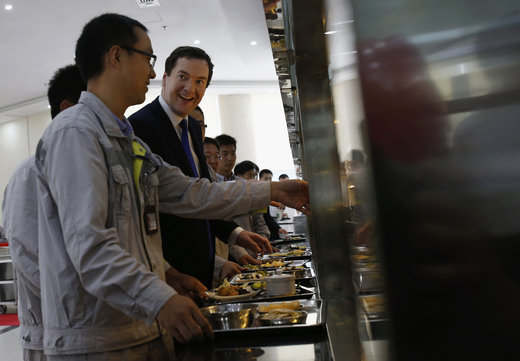23 October 2013
While the US conducts a post-mortem on its still-born nuclear “renaissance”, the UK is gearing up for the first new-build in nearly 25 years amid predictions that momentous developments in the past week will trigger a wave of new UK nuclear stations – and many billions worth of construction work.
On Monday the UK government finally gave the go-ahead for the Hinkley C power station in Somerset, setting the stage for the UK’s first nuclear new-build since Sizewell B, a pressurised water reactor in Suffolk that began construction in 1988 and came online in 1995.
It has been a difficult birthing process. The government first fired the starting pistol for a new generation of nuclear power stations in January 2008 with Hinkley Point, already home to the disused Hinkley A and the still-operational Hinkley B, identified in 2010 as one of eight sites considered.
France’s EDF Energy submitted an application for development consent in October 2011 and since then the project has been in limbo while the government and EDF negotiated a “strike price”, the minimum guaranteed price EDF will be paid for electricity produced when Hinkley C is operating – in 2023 according to the latest schedule estimates.
Those negotiations concluded this week with the government announcing on Monday that a strike price of £92.50 per megawatt hour (MWh) had been agreed. It would drop to £89.50/MWh if EDF builds a second proposed nuclear power station, Sizewell C, in Suffolk.
For the government even to offer a strike price, which obliges it to top up the operator’s income if per-MWh prices fall below the agreed level, is seen as a major, risk-reducing incentive for would-be nuclear operators in the UK.
At £89.50-£92.50/MWh, the strike price is around twice the current wholesale market rate for electricity. Wholesale rates are likely to rise, but if they don’t double in 10 years, by when when Hinkley C is hoped to be producing, this deal represents a generous subsidy for nuclear.
Hello, China
The other momentous development clearing the way for a UK nuclear renaissance was the government’s decision announced the previous Thursday (17 October) that Chinese firms would be allowed to take a stake in, or own up to 100% of new British nuclear power stations.
UK chancellor George Osborne made the announcement at China’s Taishan nuclear power plant on the last day of a trade visit to the world’s second largest economy. He said Chinese investment would likely begin with a minority stake in a power project, but majority ownership of subsequent new power stations possible.
China is by far the world leader in nuclear new-build, with a whopping 28 new power stations under construction. Russia comes a distant second, with nine.

British chancellor George Osborne talks with workers at Taishan nuclear power plant in China, October 17, 2013. (Bobby Yip/AFP/Getty Images)
The country’s biggest nuclear players lost no time. After the weekend, EDF announced that two of China’s three biggest operators, China General Nuclear Corporation (CGN) and China National Nuclear Corporation (CNNC), would team up to take a stake of between 30% and 40% in the £16bn Hinkley scheme.
EDF has worked with CGN and CNNC for years – the Taishan plant George Osborne toured in China is an EDF-CGN joint venture – but the new open-armed stance of the UK towards Chinese investment in nuclear cleared the way for them to enter the UK.
Indeed, the chance for EDF to split the risk of Hinkley with Chinese partners may well have been the strategic detonation that cleared the logjam of the strike-price negotiations.
Not quite there yet
When they come online Hinkley C’s twin, 1,600MWh reactors are expected to meet 7% of the UK’s total electricity needs.
Critics slammed the government for committing itself to what may turn out to be a generous taxpayer subsidy for nuclear. Others worried that Chinese companies lacked the transparency the public should expect in a business as risky as nuclear power generation.
But industry proponents praised the government for smoothing the way for what they believed would be a genuine nuclear renaissance in the UK.
Daniel Grosvenor, head of Deloitte’s UK nuclear practice, said the deal would “open the flood gates” for more investment.
It “shows that the UK can attract the international investment our energy sector desperately needs,” he told The Telegraph newspaper.
If it goes ahead Hinkley C will make the UK construction project pipeline bulge considerably. Contractor Laing O’Rourke, in a partnership with Bouygues, is in line to deliver the £2bn civils package on the plant, while Costain is in line for a related, £250m marine works contract.
There are, however, hurdles still to be jumped before Hinkley C is born.
First, the UK must get state aid clearance from the European Commission, a process that could take six months to a year.
Second, EDF will not press the “go” button on the scheme until EU clearance has been given, and things could change between now and then.
Plus there is opposition in the UK to nuclear in general and Hinkley C in particular.
There is also the delicate matter of construction risk, which is to be borne by EDF and its Chinese partners.
With nuclear new-build such risk can amount to a blank cheque.
EDF is currently building a nuclear plant in Flamanville, France. The first to be built in France for 15 years, it was originally expected to cost €3.3bn and be in operation by the end of last year, but costs have more than doubled and it is now scheduled to be operational by 2016.










